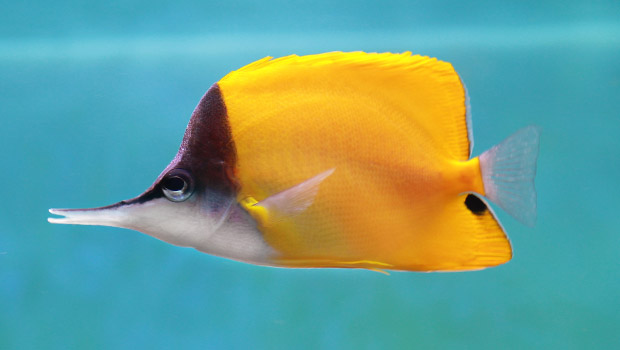Forceps Butterflyfish

The forceps butterflyfish, Forcipiger flavissimus, or lau-wiliwili-nukunuku-‘oi-‘oi in Hawaiian, is named in three languages for its elongated, forceps-like jaw. The Latin forcipiger translates as forceps-bearing, and the Hawaiian nukunuku-‘oi’oi refers to the very sharp snout. The yellow color is also noted in both names: flavissimus means yellow in Latin; and the descriptive Hawaiian name relates the similarities between the color and movements of the fish and the yellow dropping leaves of the wiliwili tree.
The forceps butterflyfish, or forcepsfish, is one of two species of Hawaiian butterflyfishes commonly known as longnose butterflyfish. The longer longnose butterflyfish, Forcipiger longirostris, has a jaw approximately one third longer than its shorter long-nosed relative. Both species share the same Hawaiian name.
Both longnose butterflyfish species probe coral branches and reef crevices for small invertebrate prey, but details of their jaw anatomy, mouth design and teeth indicate different feeding methods. The longnose butterflyfish’s mouth is designed for plucking and it takes its small prey, largely crustaceans, whole. The forceps butterflyfish, in contrast, has a mouth that opens more widely as it tears off pieces of larger prey, like the tentacles of worms and tube feet of sea urchins, as well as plucking small crustaceans and fish eggs.
The forceps butterflyfish is found throughout the Hawaiian Chain, as well as elsewhere in the Indo-Pacific and eastern Pacific regions. It is more common at shallower depths. The longnose butterflyfish has an Indo-Pacific distribution, but in Hawai’i is largely limited to the southern end of the Hawaiian Island chain, and is seen more commonly around the Big Island or Maui. It is usually seen in the deeper waters on the outer side of the reef.
Quick Facts
Hawaiian name
lau-wiliwili-nukunuku-‘oi-‘oi
Scientific name
Forcipiger flavissimus
Distribution
Indo-Pacific and tropical eastern Pacific, including Hawai‘i
Size
to 7.2 inches (18.5 cm)
Diet
small reef invertebrates
Support the Aquarium
Contact Us
Honolulu, HI 96815
(808) 923-9741
Search
- Already a Volunteer?
- Click Here To Sign In


 Donate
Donate
